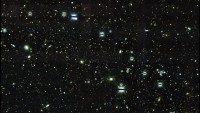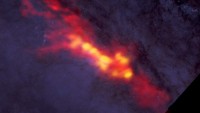One Million Stars are Forming in Nearby Dwarf Galaxy at a Rapid Rate
| Marco Foronda | | Mar 20, 2015 04:36 AM EDT |
(Photo : Jean Turner) The blue background is a Hubble Space Telescope image of galaxy NGC 5253. The white spots are young star clusters. The brightest part of the image is Cloud D.
Astronomers have observed more than a million young stars forming at a phenomenal rate in a dwarf galaxy near the Milky Way.
The star cluster is found within a dusty cloud in the tiny galaxy called NGC 5253, which is part of the Centaurus constellation, said a report published Thursday.
Like Us on Facebook
"[This] cluster is a factory of stars," said UCLA College's physics and astronomy department head Jean Turner.
Prof. Turner is also the lead researcher of the study that started years ago. Now, the team has successfully located the dusty cloud of gases the forming stars were created from.
Normally, when astronomers observe a supernebula, the dust and gases are no longer visible. In this case, they're visible.
"We were stunned," Prof. Turner remarked.
The dusty cloud is in the Cloud D region of the dwarf galaxy. It contains oxygen, carbon and other elements about 15,000 times our Sun's mass. Also, the supernebula is believed to be a billion times more luminous as it contains more than 7,000 of the most luminous stars called "O" stars.
It's hidden by the surrounding gases so it's invisible in normal light, however.
The giant star cluster is estimated to be three million years old, which is young astronomically speaking, Prof. Turner said.
The Milky Way is still forming stars, but not at the same rate as the dwarf galaxy. In fact, our own galaxy hasn't created star clusters in billions of years, according to Prof. Turner.
Some astronomers speculate star clusters only form in a young universe.
After the discovery, astronomers expect a few stars will explode into a supernova, spewing some of the dust and gas into interstellar space. The gas cloud hurled into space has a possibility of forming into clusters of more stars.
At the moment, there's no evidence of a supernova.
The international team first discovered the radio emissions of the giant star cluster in 1996. They are conducting research using the Submillimeter Array with Academia Sinica Institute of Astronomy and Astrophysics and Smithsonian Astrophysical Observatory.
TagsSpace, star cluster, dwarf galaxy, NGC 5253, supernebula, UCLA, Jean Turner, Milky Way, Supernova
©2015 Chinatopix All rights reserved. Do not reproduce without permission
EDITOR'S PICKS
-

Did the Trump administration just announce plans for a trade war with ‘hostile’ China and Russia?
-

US Senate passes Taiwan travel bill slammed by China
-

As Yan Sihong’s family grieves, here are other Chinese students who went missing abroad. Some have never been found
-

Beijing blasts Western critics who ‘smear China’ with the term sharp power
-

China Envoy Seeks to Defuse Tensions With U.S. as a Trade War Brews
-

Singapore's Deputy PM Provides Bitcoin Vote of Confidence Amid China's Blanket Bans
-

China warns investors over risks in overseas virtual currency trading
-

Chinese government most trustworthy: survey
-

Kashima Antlers On Course For Back-To-Back Titles
MOST POPULAR
LATEST NEWS
Zhou Yongkang: China's Former Security Chief Sentenced to Life in Prison

China's former Chief of the Ministry of Public Security, Zhou Yongkang, has been given a life sentence after he was found guilty of abusing his office, bribery and deliberately ... Full Article
TRENDING STORY

China Pork Prices Expected to Stabilize As The Supplies Recover

Elephone P9000 Smartphone is now on Sale on Amazon India

There's a Big Chance Cliffhangers Won't Still Be Resolved When Grey's Anatomy Season 13 Returns

Supreme Court Ruled on Samsung vs Apple Dispute for Patent Infringement

Microsoft Surface Pro 5 Rumors and Release Date: What is the Latest?













